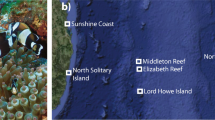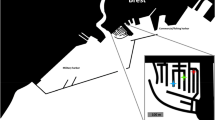Abstract
The frequency of homing behavior (percent returns to the same crevice) of Diadema antillarum Philippi varied from 30 to 84% among areas. Frequency of homing was positively correlated with predator abundance and negatively the protective quality of crevices and more readily vacates low quality crevices than more protective ones when a simulated predation attempt occurs. Previously grazed portions of the foraging range of homing individuals do not appear to be regrazed on successive nights and an avoidance of such areas is suggested. This predator-mediated behavior pattern and its effects on coral reef communities may be a tropical analog to predator-sea urchin-algal relationships in temperate marine communities.
Similar content being viewed by others
Literature cited
Birkeland, C. and B. D. Gregory: Feeding behavior of a tropical predator Cyphoma gibbosum Linnaeus. In: Tektite 2. Scientists in the sea, pp VI-58–VI-69. Ed. by J. W. Miller and J. G. Vanderwalker. Washington: U.S. Department of the Interior 1971
Carpenter, R. C.: Grazing by Diadema antillarum Philippi and its effects on the benthic algal community. J. mar. Res. 39, 749–765 (1981)
Connell, J. H.: Diversity in tropical rain forests and coral reefs. Science, N.Y. 199, 1302–1310 (1978)
Cook, A.: Homing in the Gastropoda. Malacologia 18, 315–318 (1979)
Duggins, D. O.: Kelp beds and sea otters: an experimental approach. Ecology 61, 447–453 (1980)
Emlen, J. M.: Ecology: an evolutionary approach. Reading, Massachusetts: Addison-Wesley 1973
Estes, J. A. and J. F. Palmisano: Sea otters: their role in structuring nearshore communities. Science, N.Y. 185, 1058–1060 (1974)
Fricke, H. W.: Möglicher Einfluß von Feinden auf das Verhalten von Diadema-Seeigeln. Mar. Biol. 27, 59–64 (1974)
Gladfelter, W. B., E. H. Gladfelter, D. K. Hubbard, R. C. Carpenter and G. J. Simpson: Environmental studies of Buck Island Reef National Monument, St. Croix, U.S. Virgin Islands. Report to the Department of Interior, National Park Service 1979
Grünbaum, H. G., D. P. Abbott and J. C. Ogden: Intraspecific agonistic behavior in the rock-boring sea urchin Echinometra lucunter (L.) (Echinodermata: Echinoidea). Bull. mar. Sci. 28, 181–188 (1978)
Hawkins, C. M.: Efficiency of organic matter absorption by the tropical echinoid Diadema antillarum Philippi fed non-macrophytic algae. J. exp. mar. Biol. Ecol. 49, 245–253 (1981)
Hay, M. E.: Patterns of fish and urchin grazing in Caribbean coral reefs: are previous results typical? Ecology 65, 446–454 (1984)
Helfman, G. S.: Underwater methods. In: Fisheries techniques manual, Chapter 19, pp 349–369. Ed. by L. A. Nielsen and D. L. Johnson. Bethesda, Maryland: American Fisheries Society 1983
Hixon, M. A. and W. N. Brostoff: Damselfish as keystone species in reverse: intermediate disturbance and diversity of reef algae. Science, N.Y. 220, 511–513 (1983)
Jones, R. S. and M. J. Thompson: Comparison of Florida reef fish communities by the employment of a rapid visual technique. Bull. mar. Sci. 28, 159–172 (1978)
Lawrence, J. M.: On the relationship between marine plants and sea urchins. Oceanogr. mar. Biol. A. Rev. 13, 213–286 (1975)
Lowry, L. F. and J. S. Pearse: Abalones and sea urchins in an area inhabited by sea otters. Mar. Biol. 23, 213–219 (1973)
Lubchenco, J.: Plant species diversity in a marine intertidal community: importance of herbivore food preference and algal competitive abilities. Am. Nat. 112, 23–39 (1978)
Mann, K. H. and P. A. Breen: The relationship between lobster abundance, sea urchins and kelp beds. J. Fish. Res. Bd Can. 29, 603–605 (1972)
Mattison, J. E., J. D. Trent, A. L. Shanks, T. B. Akin and J. S. Pearse: Movement and feeding activity of red sea urchins (Strongylocentrotus franciscanus) adjacent to a kelp forest. Mar. Biol. 39, 25–30 (1977)
Millot, N.: Light emission and light perception in species of Diadema. Nature, Lond. 171, 973–974 (1953)
Millot, N.: Sensitivity to light and the reactions to changes in light intensity of the echinoid Diadema antillarum Philippi. Phil. Trans. R. Soc. 238, 187–220 (1954)
Mortensen, T.: A monograph of the Echinoidea. III, I. Aulodonta. Copenhagen: C. A. Reitzel 1940
Nelson, B. V. and R. R. Vance: Diel foraging patterns of the sea urchin Centrostephanus coronatus as a predator avoidance strategy. Mar. Biol. 51, 251–258 (1979)
Ogden, J. C.: Carbonate-sediment production by parrotfish and sea urchins on Caribbean reefs. Bull. Am. Assoc. Pet. Geol. 4, 281–288 (1977)
Ogden, J. C., R. A. Brown and N. Salesky: Grazing by the echinoid Diadema antillarum Philippi: formation of halos around West Indian patch reefs. Science, N.Y. 182, 715–716 (1973)
Paine, R. T.: Food web complexity and species diversity. Am. Nat. 100, 56–75 (1966)
Randall, J. E., Food habits of reef fishes of the West Indies. Stud. trop. Oceanogr. 5, 665–847 (1967)
Randall, J. E., R. E. Schroeder and W. A. Starck: Notes on the biology of the echinoid Diadema antillarum Caribb. J. Sci. 4, 421–433 (1964)
Sammarco, P. W.: Diadema and its relationship to coral spat mortality: grazing, competition and biological disturbances. J. exp. mar. Biol. Ecol. 45, 245–272 (1980)
Sammarco, P. W.: Effects of grazing by Diadema antillarum Philippi (Echinodermata: Echinoidea) on algal diversity and community structure. J. exp. mar. Biol. Ecol. 65, 83–105 (1982)
Sammarco, P. W., J. S. Levinton and J. C. Ogden: Grazing and control of coral reef community structure by Diadema antillarum Philippi (Echinodermata: Echinoidea): a preliminary study. J. mar. Res. 32, 47–53 (1974)
Scheibling, R. E.: Optimal foraging movements of Oreaster reticulatus (L.) (Echinodermata: Asteroidea). J. exp. mar. Biol. Ecol. 51, 173–185 (1981)
Sloan, N. and A. Campbell: Perception of food. In: Echinoderm nutrition. Ed. by M. Jangoux and J. M. Lawrence Rotterdam: A. A. Balkema 1982
Sokal, R. R. and F. J. Rohlf: Biometry the principles and practice of statistics in biological research, 2nd ed., 859 pp San Francisco, Calif.: W. H. Freeman 1981
Stearn, C. W. and T. P. Scoffin: Carbonate budget of a fringing reef, Barbados. Proc. Third Int. Coral Reef Symp. 2, 471–476 (1977)
Stimson, J.: The role of the territory in the ecology of the intertidal limpet Lottia gigantea (Gray). Ecology 54, 1020–1030 (1973)
Thorton, I. W. B.: Diurnal migrations of the echinoid Diadema setosum (Leske). Br. J. Anim. Behav 4, 143–146 (1956)
Vance, R. R.: Effects of grazing by the sea urchin, Centrostephanus coronatus, on prey community composition. Ecology 59, 679–685 (1979)
Vance, R. R. and R. J. Schmitt: The effect of predator-avoidance behavior of the sea urchin, Centrostephanus coronatus, on the breadth of its diet. Oecologia 44, 21–25 (1979)
Wharton, W. G. and K. H. Mann: Relationship between destructive grazing by the sea urchin, Strongylocentrotus droebachiensis, and the abundance of American lobster, Homarus americanus, on the Atlantic coast of Nova Scotia. Can. J. Fish. aquat. Sci. 38, 1339–1349 (1981)
Woodley, J. D.: Photosensitivity of Diadema antillarum: does it show scototaxis? Abstract. In: Echinoderms: Proc. Int. Conf., Tampa Bay. Ed. by J. M. Lawrence. Rotterdam: A. A. Balkema 1982
Zar, J. H.: Biostatistical analysis. Englewood Cliffs, New Jersey: Prentice-Hall 1974
Author information
Authors and Affiliations
Additional information
Communicated by J. M. Lawrence, Tampa
Contribution of the Institute of Ecology, University of Georgia and Contribution No. 123 of the West Indies Laboratory, Fairleigh Dickinson University
Rights and permissions
About this article
Cite this article
Carpenter, R.C. Predator and population density control of homing behavior in the Caribbean echinoid Diadema antillarum . Mar. Biol. 82, 101–108 (1984). https://doi.org/10.1007/BF00392768
Accepted:
Issue Date:
DOI: https://doi.org/10.1007/BF00392768




